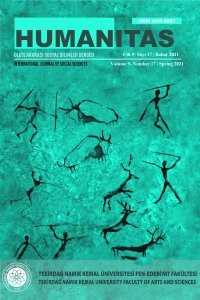Öz
Raja Rao’s Kanthapura (1938) focuses on the story of how Gandhian ideology reaches the village of Kanthapura and changes the villagers’ lives drastically. Rao’s portrayal of national identity, by putting the village in the center, relies heavily on the use of centuries-old Indian culture and traditions in order to create a sense of shared history and collective sense of belonging against British colonialism. In the novel, the villagers re-discover their shared cultural and religious past in their attempt to find the strength to fight against colonial domination and envision a new society. Thus, the narrative’s imagining of the future society follows a past-oriented trajectory, namely combining the past, present and future in the microcosmos of the village. I contend that the temporal origin of the projected nationhood determines the limitations and possibilities for the formation of the idea of nation and the future society.
Anahtar Kelimeler
Postcolonial literature India national culture Raja Rao Kanthapura
Kaynakça
- Anderson, B. (2006). Imagined communities: Reflections on the origin and spread of nationalism. New York: Verso.
- Chatterjee, M. (2000). Khadi: The fabric of the nation. New Literature Review, 36, 105-113.
- Chatterjee, P. (1993). The nation and its fragments: Colonial and postcolonial histories. Princeton: Princeton University Press.
- Gopal, P. (2009). The Indian English novel: Nation, history, and narration. Oxford: Oxford University Press.
- Jain, J. (2007). A phoenix called resistance. Journal of Postcolonial Writing, 43(2), 172-182.
- Khair, T. (2001). Babu fictions: Alienation in contemporary Indian English novels. New York: Oxford University Press.
- Lazarus, N. (2011). The postcolonial unconscious. New York: Cambridge University Press.
- McLeod, J. (2013). Postcolonialism and literature. In G. Huggan (Ed.), The Oxford handbook of postcolonial studies (p. 449-467). New York: Oxford University Press.
- Mohan, A. (2012). Utopia and the village in South Asian literatures. New York: Palgrave MacMillan.
- Mondal, A. (2002). The emblematics of gender and sexuality in Indian nationalist discourse. Modern Asian Studies, 36(4), 913-936.
- Monti, A. (2001). A plea and a cheer for Indian English: A note on Raja Rao. In R. Mittapalli and Piciucco, P.P. (Eds.) The fiction of Raja Rao: Critical studies (p. 53-61). New Delhi: Atlantic Publishers and Distributors.
- Moorty, S.S. (1996). Narrative technique in Raja Rao’s Kanthapura. Commonwealth, 19(1), 111-15.
- Nair, M. K. (1982). Raja Rao. Calcutta: Blackie and Son Publishers.
- Prasad, G. J. V. (2011). Writing India, writing English: Literature, language, location. New York: Routledge.
- Rao, R. (1963). Kanthapura. New York: New Directions.
- Sethi, R. (1996). Contesting identities: Involvement and resistance of women in the Indian national movement. Journal of Gender Studies, 5(3), 305-315.
- Sethi, R. (1999). Myths of nation: national identity and literary representation. Oxford: Clarendon Press.
- Shingavi, S. (2013). The Mahatma misunderstood: The politics and forms of literary nationalism in India. New York: Anthem Press.
- Srivastava, N. (2010). Towards a critique of colonial violence: Fanon, Gandhi and the restoration of agency. Journal of Postcolonial Writing, 46(3-4), 303-319.
Öz
Anahtar Kelimeler
Postkolonyal Edebiyat Hindistan Ulusal Kültür Raja Rao Kanthapura
Kaynakça
- Anderson, B. (2006). Imagined communities: Reflections on the origin and spread of nationalism. New York: Verso.
- Chatterjee, M. (2000). Khadi: The fabric of the nation. New Literature Review, 36, 105-113.
- Chatterjee, P. (1993). The nation and its fragments: Colonial and postcolonial histories. Princeton: Princeton University Press.
- Gopal, P. (2009). The Indian English novel: Nation, history, and narration. Oxford: Oxford University Press.
- Jain, J. (2007). A phoenix called resistance. Journal of Postcolonial Writing, 43(2), 172-182.
- Khair, T. (2001). Babu fictions: Alienation in contemporary Indian English novels. New York: Oxford University Press.
- Lazarus, N. (2011). The postcolonial unconscious. New York: Cambridge University Press.
- McLeod, J. (2013). Postcolonialism and literature. In G. Huggan (Ed.), The Oxford handbook of postcolonial studies (p. 449-467). New York: Oxford University Press.
- Mohan, A. (2012). Utopia and the village in South Asian literatures. New York: Palgrave MacMillan.
- Mondal, A. (2002). The emblematics of gender and sexuality in Indian nationalist discourse. Modern Asian Studies, 36(4), 913-936.
- Monti, A. (2001). A plea and a cheer for Indian English: A note on Raja Rao. In R. Mittapalli and Piciucco, P.P. (Eds.) The fiction of Raja Rao: Critical studies (p. 53-61). New Delhi: Atlantic Publishers and Distributors.
- Moorty, S.S. (1996). Narrative technique in Raja Rao’s Kanthapura. Commonwealth, 19(1), 111-15.
- Nair, M. K. (1982). Raja Rao. Calcutta: Blackie and Son Publishers.
- Prasad, G. J. V. (2011). Writing India, writing English: Literature, language, location. New York: Routledge.
- Rao, R. (1963). Kanthapura. New York: New Directions.
- Sethi, R. (1996). Contesting identities: Involvement and resistance of women in the Indian national movement. Journal of Gender Studies, 5(3), 305-315.
- Sethi, R. (1999). Myths of nation: national identity and literary representation. Oxford: Clarendon Press.
- Shingavi, S. (2013). The Mahatma misunderstood: The politics and forms of literary nationalism in India. New York: Anthem Press.
- Srivastava, N. (2010). Towards a critique of colonial violence: Fanon, Gandhi and the restoration of agency. Journal of Postcolonial Writing, 46(3-4), 303-319.
Ayrıntılar
| Birincil Dil | İngilizce |
|---|---|
| Bölüm | Tüm Sayı |
| Yazarlar | |
| Yayımlanma Tarihi | 15 Mart 2021 |
| Yayımlandığı Sayı | Yıl 2021 Cilt: 9 Sayı: 17 |








